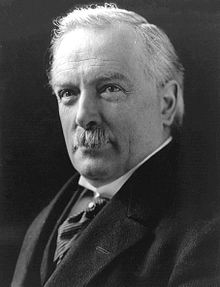Munitions crisis of 1915
The ammunition crisis of 1915 , also the ammunition crisis of spring 1915 , ( English Shell Crisis ) was the lack of artillery shells on the western front of the First World War on the part of the British Expeditionary Force . The shortage caused by planning errors in peacetime contributed significantly to the failure of the first British offensive at the Battle of Neuve-Chapelle in March 1915. After this was made known to the public in the United Kingdom by the British daily newspapers The Times and Daily Mail , the First Government under Herbert Henry Asquith was dissolved and the Second Asquith Government was formed with a newly established Ministry of Munitions on May 25, 1915 To improve the framework conditions for ammunition production with the aim of maximizing the same, the Munitions of War Act was passed by the British Parliament on July 2, 1915.
Lack of ammunition
Artillery became increasingly important at the end of the 19th century, which is why armies increased their stocks of artillery ammunition. In 1914, several armies had stocked up to 1,000–1500 projectiles per piece of artillery, which should be enough for half a year. Larger supplies would have run the risk of obsolescence over time.
These supplies were quickly used up. Since the First Battle of the Marne there was a shortage of ammunition in the French army, other armies, etc. a. the British and the German suffered as of November. The grave war exacerbated the problem: The ammunition had to fight rather than infantry in open terrain, destroying large field fortifications, while the number of targets increased. The government's factories could not produce enough, which is why several private factories had to remove the production bottleneck. However, they did not have any trained specialists, which is why many orders could not be fulfilled on time. For the Central Powers , there was also a lack of raw materials because of the occupied colonies . Eventually the focus has shifted to quantity rather than quality, e.g. B. the German army used cast iron instead of steel.
The Times and Daily Mail attack Lord Kitchener
After Charles à Court Repington , the war correspondent for The Times , observed the British defeat in the Battle of Aubers Ridge in May 1915 and his close friend John French mentioned an ammunition shortage, he denounced this and indirectly Lord Kitchener in a telegram to The Times on. This was published on May 14, 1915 under the heading "Need for shells: British attacks checked: Limited supply the cause: A Lesson From France" by Lord Northcliffe , owner of The Times and Daily Mail . Lord Northcliffe also published a scandalous article in the Daily Mail on May 21st about the crisis under the headline The Tragedy of Shells: Lord Kitchener's grave error .
Political Consequences
Formation of the Second Asquith Government
Asquith sent a letter urging his ministers to resign, whereupon he formed a new government on May 19 with David Lloyd George as Minister of Munitions. But he did this mainly because of the resignation of John Fisher , the former First Sea Lord , on May 15th. The dissolved government was the last fully liberal government in the UK.
Munitions of War Act 1915
The Munitions of War Act 1915 , passed on July 2, ended the crisis. According to Sir John Marriott, the text read:
“No private interest was to be permitted to obstruct the service, or imperil the safety, of the state. Trade Union regulations must be suspended; employers' profits must be limited, skilled men must fight, if not in the trenches, in the factories; man-power must be economize by the dilution of labor and the employment of women; Private factories must pass under the control of the State, and new national factories be set up. "
“No private interest was allowed to restrict the service of the state or security. Union rights are suspended; The employers' profits must be limited; experienced men must fight in the factories , if not in the ditch ; Manpower must be saved by diluting labor and employing women; Private factories must be under the control of the state and new national factories must be built. "
Ministry of Munitions
After the creation of the ministry, new factories were built. Since it would be some time before these factories would be built, several railroad factories were converted into ammunition factories. These railroad factories were particularly suitable because they already had suitable staff and machinery.
There were three explosions in such ammunition factories:
- 1916 in Faversham with 105 dead
- 1917 in Silverton with 73 dead and more than 400 injured
- 1918 in Chilwel with 137 dead
literature
- Lloyd George, David, (1933). War memoirs of David Lloyd George. London: Ivor Nicholson & Watson.
- Adams, RJQ, (1978). Arms and the Wizard: Lloyd George and the Ministry of Munitions 1915-1916. London: Cassell. ISBN 0-304-29916-2 .
- Carnegie, David (1925). The History of Munitions Supply in Canada 1914-1918. London: Longmans Green and Co.
Individual evidence
- ↑ a b Shells Crisis of 1915 , Hew Strachan , February 26, 2016, accessed April 19, 2020
- ^ Who's Who - Charles Repington. Retrieved April 12, 2020 .
- ↑ The National Archives: The Tragedy of the Shells , March 5, 2015, accessed April 23, 2020
- ↑ Holmes, Richard (2004). The Little Field Marshal: A Life of Sir John French. Weidenfeld & Nicolson. pp. 289-290. ISBN 978-0-297-84614-7
- ↑ JAR Marriott, Modern England: 1885-1945 (4th ed. 1948) p. 376
- ^ Pratt, Edwin A (1921). British Railways and the Great War Book. London: Selwyn and Blount. ISBN 978-1-1518-5240-3 .

